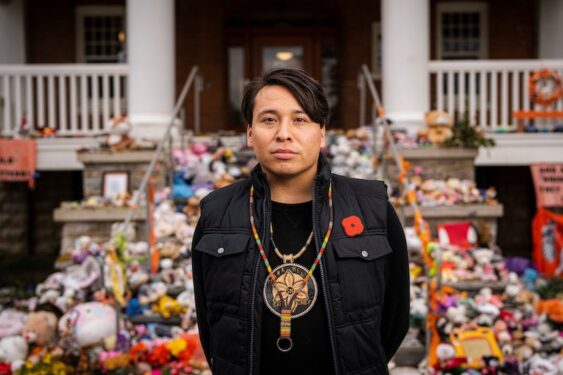By Michael Swan
TORONTO (CNS) — Beginning March 28, residential school survivors, Indigenous elders and youth will meet with Pope Francis at the Vatican as a prelude to a papal trip to Canada. The Indigenous want an apology, on Canadian soil, for historic abuses they suffered at government-owned residential schools, many of which were run by the Catholic Church.

Religious orders that ran Canada’s schools have apologized, engaged with Indigenous communities, partnered with them on healing projects. Last year, every Canadian bishop apologized for the Catholic Church’s complicity in the government’s program of assimilation, which wreaked havoc on Indigenous families and cultures.
[Related: Two new Canadian Indigenous Leaders to Prioritize Reconciliation]
But if average lay Catholics aren’t involved in some way in reconciliation, will there be reconciliation?
From the Indigenous side of the table, that contact with Catholics in pews matters, said Rachael Crawford-Rendine, co-creator of the Royal Bank of Canada’s first Indigenous employee group and a member of the RBC’s elder council.
Speaking to about 35 members of Ignite, the St. Patrick’s Parish young adult group in Toronto, Crawford-Rendine encouraged the young people to seek out opportunities for reconciliation.
“You have an opportunity to be part of the solution,” said Crawford-Rendine, whose Algonquin spirit name translates into “Blue Morning Dancer.”
Crawford-Rendine considers herself blessed to have been raised in the church and guided by the Indigenous spiritual and cultural values of her father. It gives her a perspective on the world and her own life. She has learned that reconciliation is not easy.
“The listening is the hard part,” she said. “This is definitely an important time for us to come together for listening.”
Getting that listening started in parishes and schools across the country has been a major focus for the Jesuits, who have ordered the Jesuit Forum for Social Faith and Justice to promote listening circles wherever they can.
Last year, the Jesuits teamed up with the Catholic publisher Novalis to produce “Listening to Indigenous Voices,” a kind of guide book for Indigenous and non-Indigenous Canadians to meet in structured encounters, where they can examine Canada’s history and, particularly, the history of residential schools.
Jesuit Forum executive director Mark Hathaway estimates about 4,000 copies of the guidebook have been distributed to schools, parishes and individuals.
That doesn’t translate into 4,000 listening circles. There have been pioneering efforts at the Oblates’ St. Joseph Parish in Ottawa. The Jesuits’ Our Lady of Lourdes Parish in Toronto has begun a series of listening circles. There’s interest at Holy Name Parish, also in Toronto. At St. Ann, home of the Native Peoples’ Mission in Toronto, there’s a modified and simplified version of the “Listening to Indigenous Voices” model running through this spring.
The hope at St. Ann’s is that people from across the Archdiocese of Toronto will get a taste of the listening circles experience and take it back to their own parishes.
The listening circles idea has leaned heavily on the Jesuits’ own resources throughout Ontario: at the Anishinabe Spiritual Centre in Espanola, the Martyrs’ Shrine in Midland, and the Jesuit retreat houses in Guelph and Pickering.
Catholic school boards have expressed interest, and the Jesuit Forum led an introductory session with about 50 social workers from the Toronto Catholic District School Board recently. Getting listening circles into the schools “will take some time,” Hathaway said. There has also been interest at Catholic universities.
If it has been hard to get action on reconciliation started in parishes, it may be because good intentions are not matched by organizational resources, said Sister Patricia Lourdes Lao, a member of the Sisters of Our Lady of the Missions and Native Peoples’ Mission pastoral associate.
“It’s really a marginal work of the church that depends solely on volunteer support and the generous hearts of those who are passionate about reconciliation work,” she said.
Sister Lao said she believes the listening circles model could use some support from higher up.
“We do not have that kind of structural support to enable this to happen in different parishes,” she said. “Even if there is a group of people who are dedicated or interested in having this resource in their localities, there is the problem of funding.”
Finding an elder, connecting with Indigenous people in the community, learning about ways Indigenous spirituality has been incorporated into the liturgy of the Church are big tasks for individual parishes to take on without support.
“There is no office of Indigenous relations, for example. Those are the areas that need to be done before this more public involvement happens, or church involvement happens. It has to be really instituted in the church,” said Sister Lao. “It’s a matter of structure.”
In some parishes, having an elder lead the congregation in a smudging ceremony at the beginning of Mass could be a first step. But it can also be a problem if the people aren’t prepared.
“We have some pushback from Catholics who are not so used to the smudging ceremony and think of it as pagan, or they become afraid of that ceremony,” said Sister Lao.
For urban Catholics who have little or no contact with Indigenous people, there’s a lot to learn about the reconciliation work already going on in rural Canada, on reserves and in small towns, said Redemptorist Father Santo Arrigo.
“In the small towns and the reserves, who is working up there to walk with the people? It’s the church. We have not abandoned the people. We’re with them now,” he said.
If people’s only understanding of reconciliation between the church and Indigenous people comes from news reports the picture is incomplete, Father Arrigo said. The listening circle model has the potential to get Catholics involved in the story: “This puts it front and center.”
